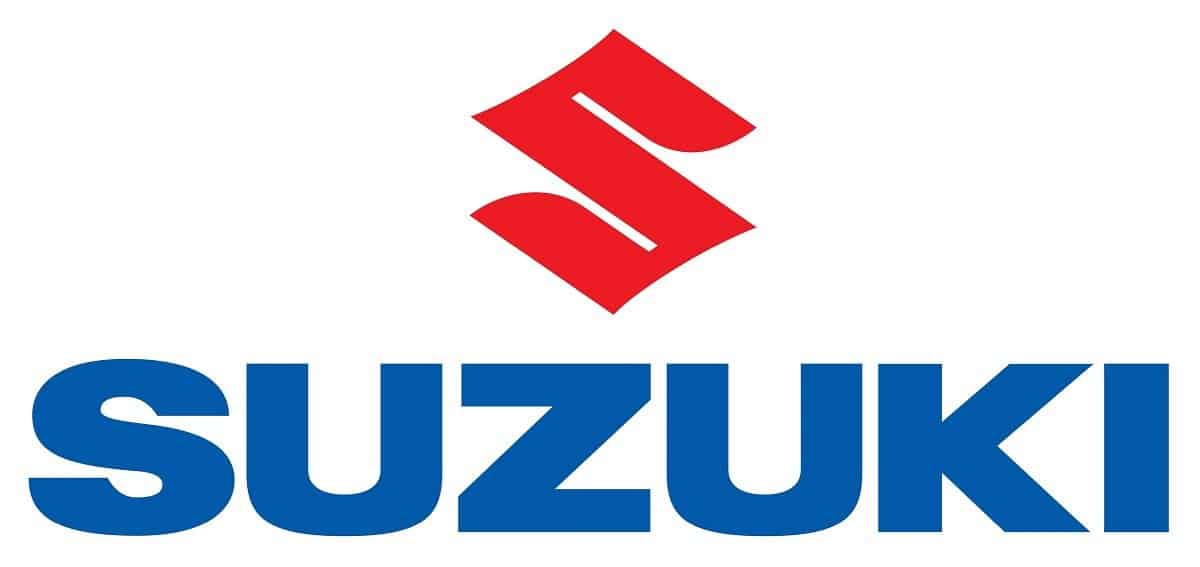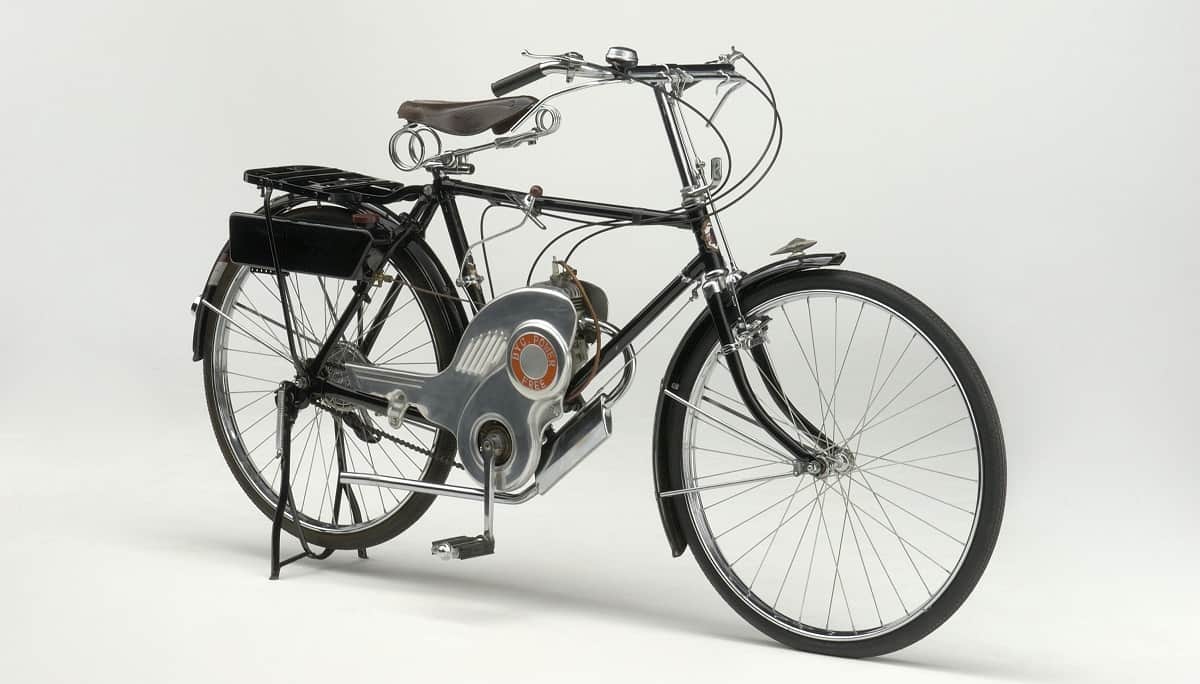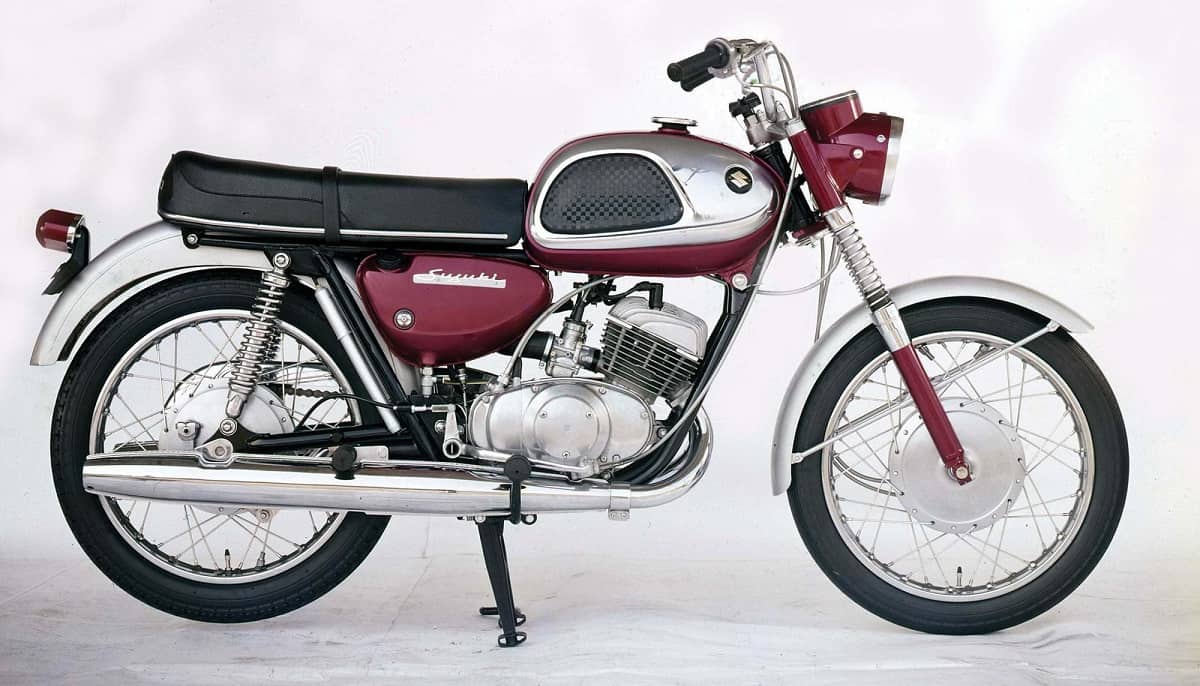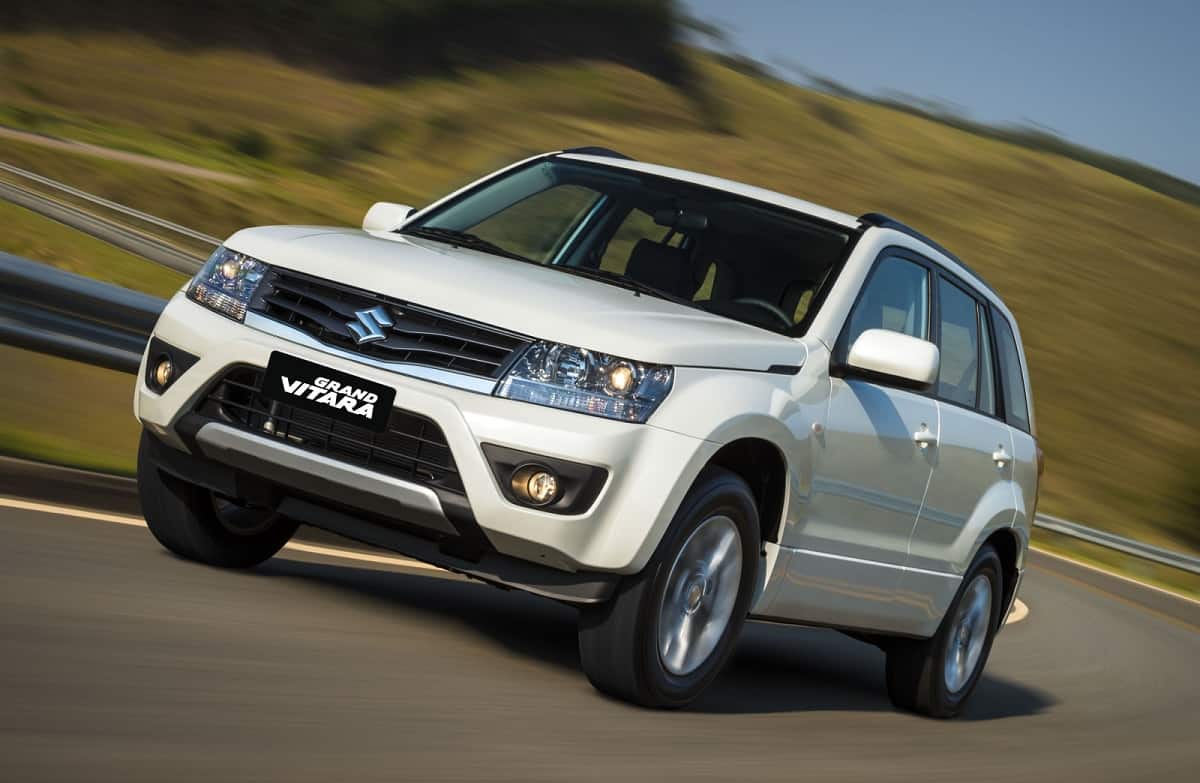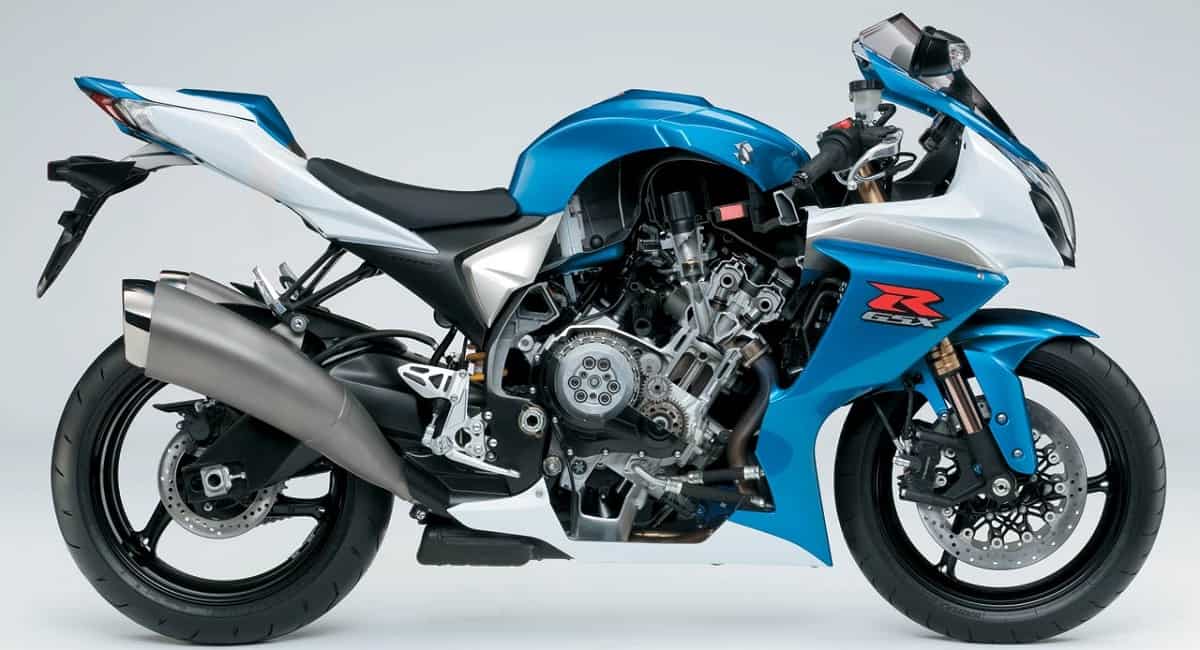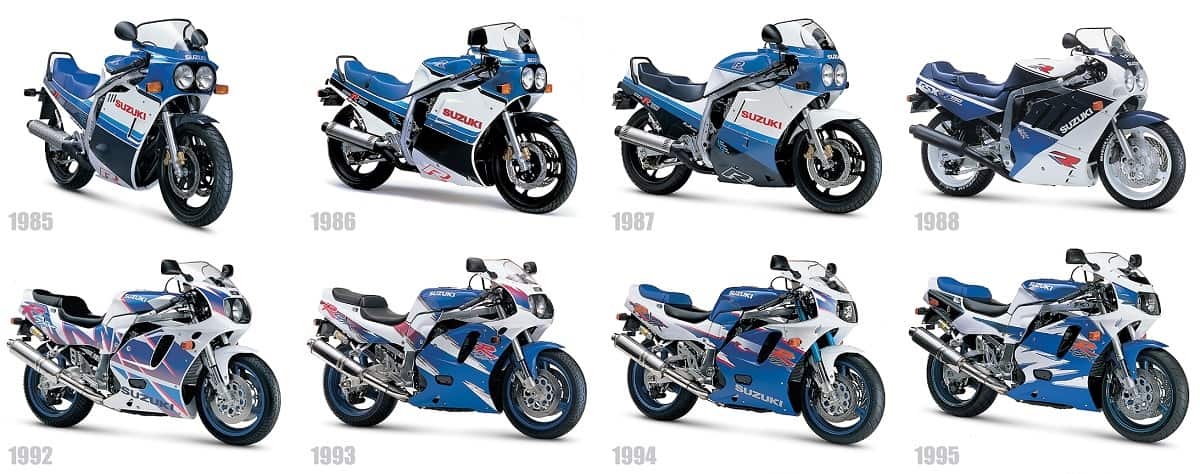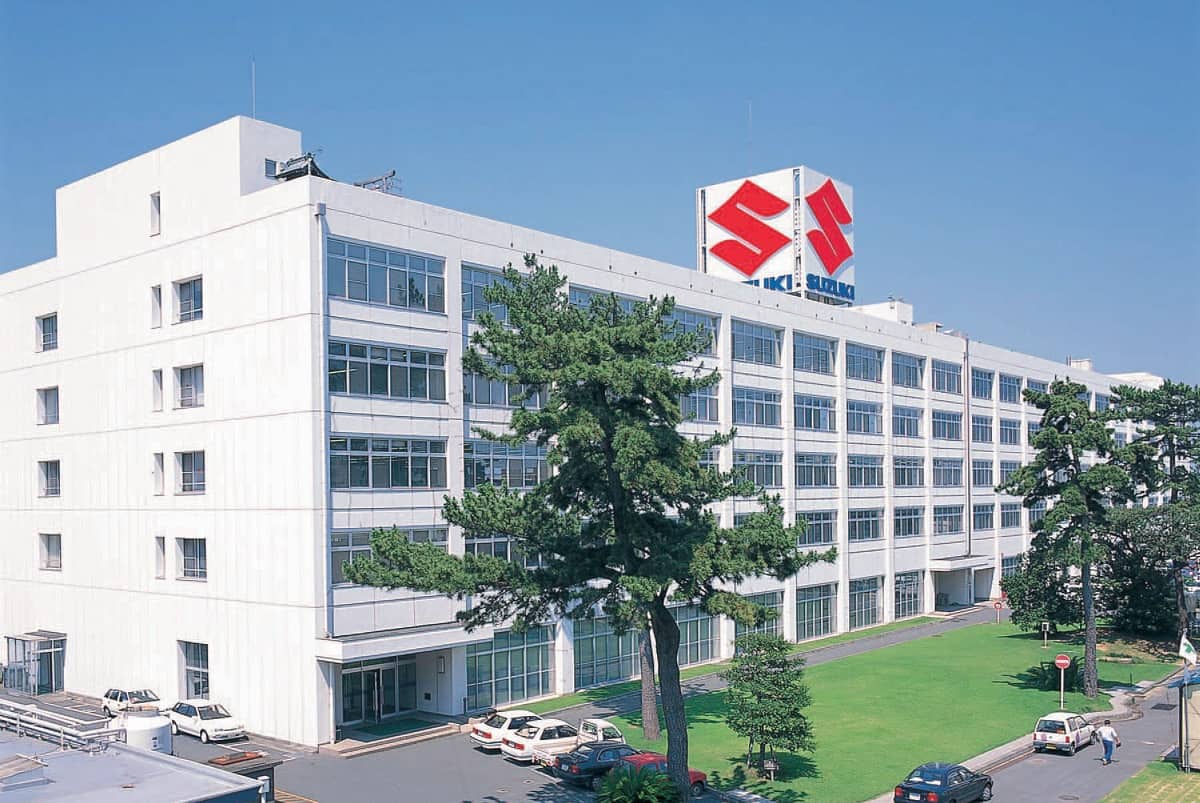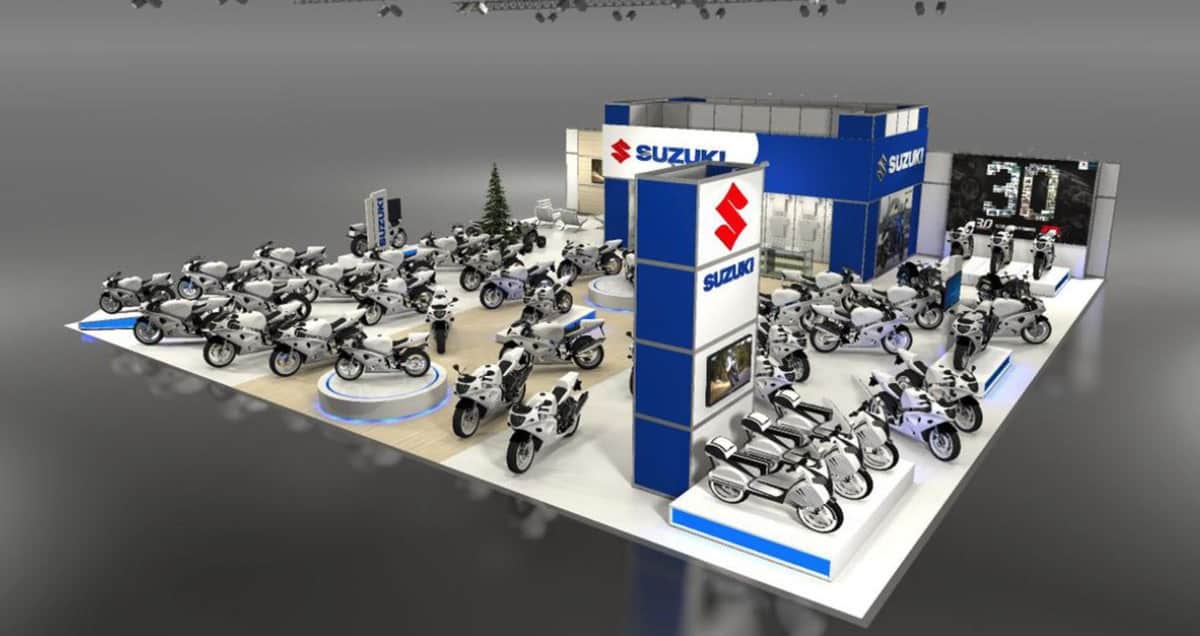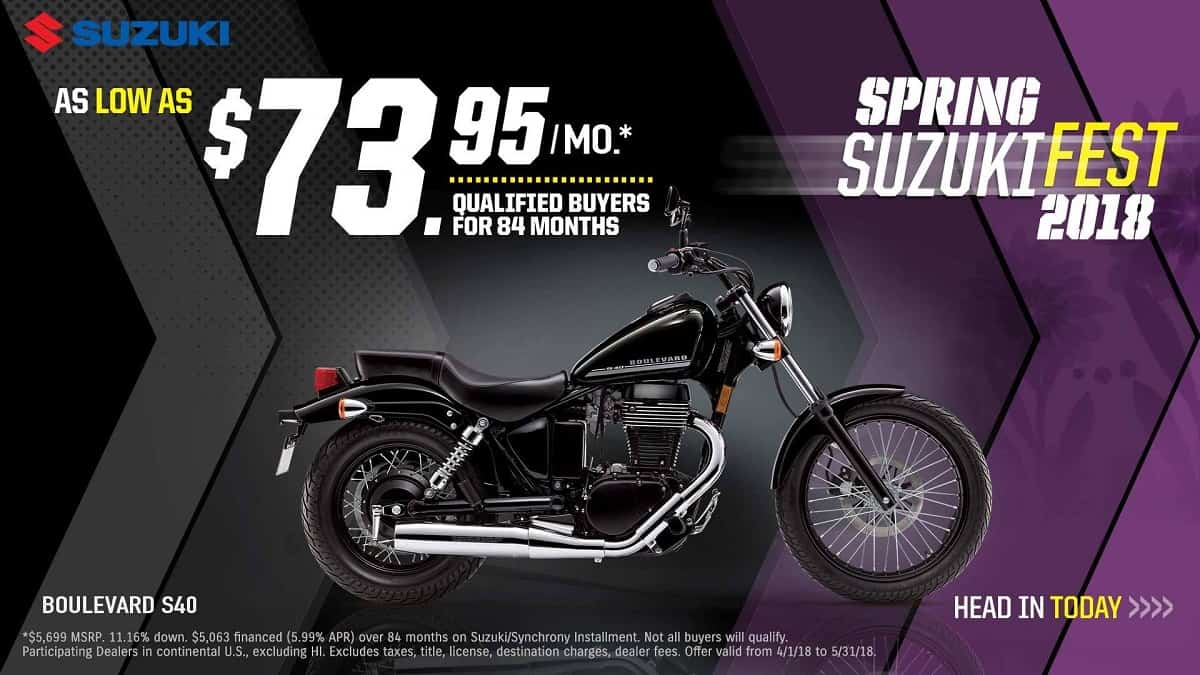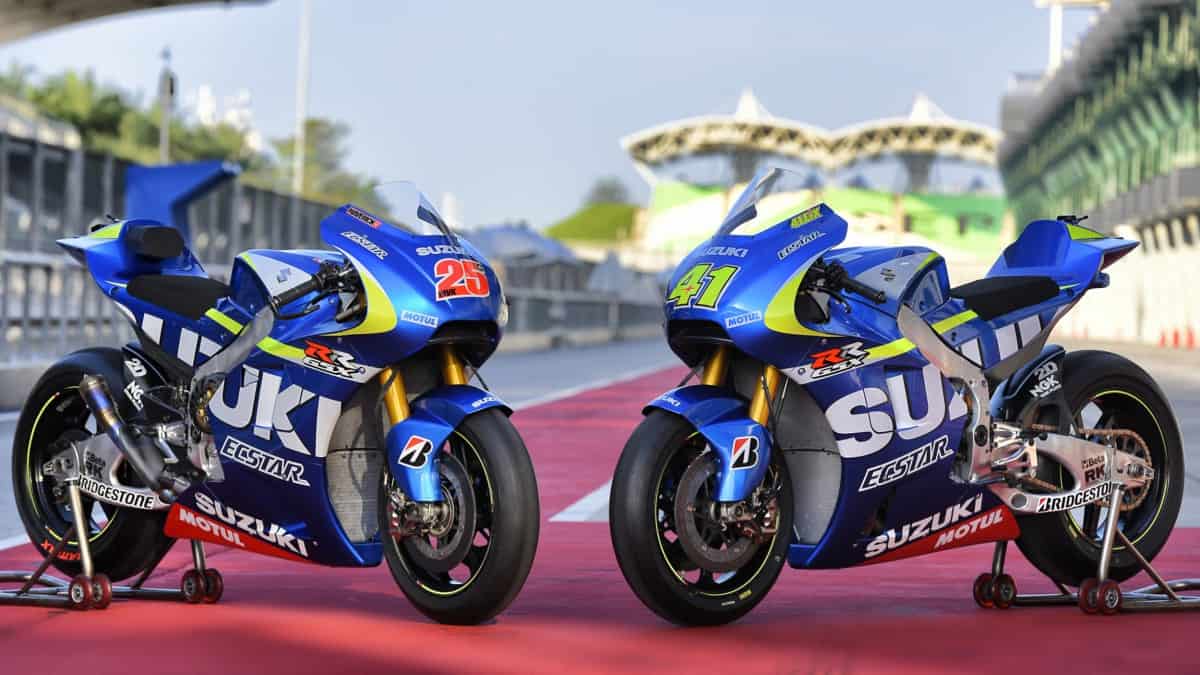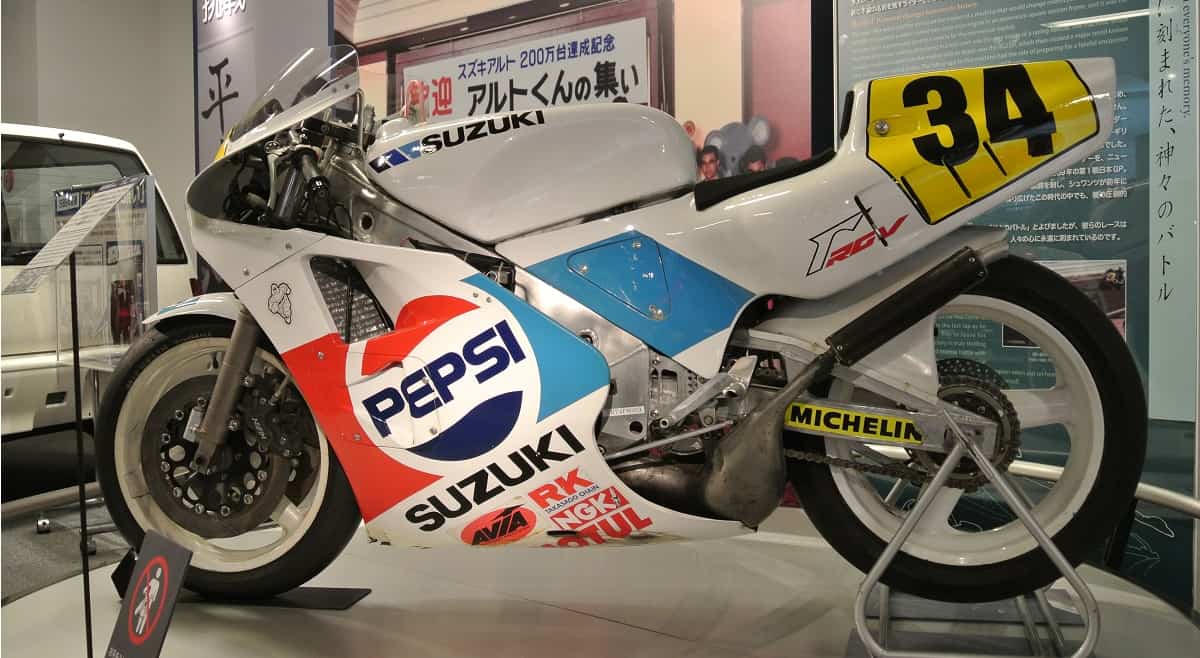The Suzuki Motor Corporation is a Japanese multinational corporation based out of the city of Hamamatsu in Japan’s Shizuoka prefecture. The company was first founded in 1909 as a loom works by Michio Suzuki. Since then, the company has expanded and diversified a great deal, and now specializes in manufacturing motorcycles, automobiles, four-wheel drive vehicles, ATVs, outboard marine engines, and small internal combustion engines. Suzuki is regarded as one of the world’s foremost motorcycle manufacturer and is named as one of the “Big Four” Japanese motorcycle manufacturers. Employing more than 45,000 across the globe, with 35 production facilities in 23 countries and more than 130 distributors in 192 countries, Suzuki is nothing short of an automotive giant.
As one of the most successful and renowned motorcycle manufacturers on the planet, Suzuki has cultivated a reputation for producing high-performance motorcycles with unparalleled reliability that retail for affordable prices. With a history of excellence that follows a timeline that includes the early T20 Super-Six two-stroke racer, the legendary RG500, the world famous GSX-R range, and the unbeatable GSX1300R Hayabusa, Suzuki is one of the most formidable motorcycle manufacturers of all time, and one of the most celebrated too. As the company motto suggests, Suzuki truly is a “Way Of Life!”
The History Of Suzuki Motorcycles
Suzuki: The Early Years
Suzuki might be one of the most famous motorcycle and automotive manufacturers in the world but it started life in an entirely different field. In 1909, Michio Suzuki first founded the Suzuki Loom Works, building weaving looms to help support Japan’s booming silk industry. Based out of Hamamatsu in Japan’s Shizuoka prefecture, Michio Suzuki rode the success of the silk trade and began inventing more innovative and productive weaving machinery with so much success that he was able to export his machines overseas. In 1920, Michio Suzuki made his company public, and the Suzuki Loom Manufacturing Company was formed.
Suzuki enjoyed unrelenting success until the mid-1930s, when a more militaristic government sought to transform the Japanese industrial landscape, refocusing on war-related manufacture. Many Japanese businesses were requested to convert their output into military pursuits, and since the Suzuki had a reputation for building quality machinery and equipping other factories, the brand was an attractive acquisition for the Japanese government. From 1937 onward, Suzuki had started producing armor, armaments, gun parts, vehicle parts, and more. During this time, Suzuki produced its first prototype vehicles, with some equipped with an innovative liquid-cooled, four-stroke engine configuration, which was unusual for the time. Despite the new-military focus, Suzuki actually continued to produce looms throughout the war.
The outcome of World War Two did not fall in Japan’s favor, but fortunately the city of Hamamatsu emerged from the war relatively unscathed, and the Suzuki factory was able to resume loom production after the war. However, Japan’s post-war economy was left in tatters, and the demand for weaving looms was at an all-time low.
Fortunately, the Suzuki factory and the city of Hamamatsu escaped the ravages of U.S. bombing campaigns. The company was capable of resuming production after the war, but the economy and supply networks were in ruins. There was a glint of hope with a new textile supply trade deal with the USA, but that ultimately collapsed in the early 1950s. Post-war Japan was in need of small-capacity, affordable transport options, and the Suzuki factory had the machinery, the knowledge, and the need to produce a new product, so the company revived their short-lived motor vehicle campaign, and produced their firs offering, the “Power Free” motor-bicycle in 1952. Powered by a clip-on 36cc, 1 horsepower, two-stroke engine, the Power Free was Suzuki’s first commercially available motorcycle, and the start of a new chapter in the company’s history.
Expansion And Innovation
Over the next couple of years, Suzuki was producing more than 6,000 motorcycles per month, and by 1954 the company was now known as the Suzuki Motor Co., Ltd. Whilst developing new motorcycles, Suzuki also began working on their first compact automobiles, such as the 1955 Suzuki Suzulight in both sedan and van configurations. Suzuki’s new motorcycles included the revolutionary twin-cylinder, two-stroke 125, called the Colleda Sel Twin, which boasted an electric starter, and came emblazoned with Suzuki’s famous “S” logo. As the 60s rolled around, Suzuki began looking outside of Japan and realized that the best way to secure new markets would be to excel on the race track. After two lackluster seasons in 1960 and 1961, Suzuki managed to secure their first GP win in the 50cc class, which would eventually lead to Suzuki claiming the 1962 championship title, and the title for the next five years too!
In an attempt to crack the US market, Suzuki introduced the T20 Super Six, a 250cc, two-stroke, twin-cylinder motorcycle that boasted a claimed top speed of 99 mph, dubbing it the fastest 250cc motorcycle in the world. The T20 didn’t just appeal to the American public, it appealed to every rider on the planet, making it a phenomenal sales success. In response to their new found fame, Suzuki was quick to launch new production factories in Thailand and Japan to keep up with demand. Over the next 10 years, Suzuki continued to improve and innovate their motorcycle platforms, winning Isle of Man TT races, and securing their first 500cc world title, with legendary racer Barry Sheene piloting his RG500 into first place in 1976. At the same, Suzuki released the GS750, the company’s first big four-cylinder motorcycle. The GS750 would be made famous thanks to Pops Yoshimura, who entered into the AMA superbike category, securing victory at Laguna Seca.
During this time, Suzuki continued to open foreign divisions all over the world, with separate subsidiaries springing up in Europe and Asia to help drive production and sell their motorcycles and cars. Suzuki’s automotive arm booms thanks to the success of the likes of their Jimny 4X4, and compact Alto range. Despite their automotive sales success, Suzuki’s motorcycles generated more interest – none more so than the GSX series which was launched in 1980: a series of sports-touring motorcycles with four-stroke DOHC, four-valve engines that would pave the way for one of the most iconic names in motorcycling history…
The Suzuki GSX-R And Beyond
First released in 1984, the Suzuki GSX-R750 fast became a legend, set the foundations for Suzuki’s design direction for the next 30 years. Essentially, the GSX-R750 was a “race bike with lights” and the closest thing to a race-ready motorcycle that the average consumer could buy. It defied the offerings on sale by Honda and Yamaha by opting for an easy and simple inline-four engine configuration, and came equipped with a revolutionary frame that featured welded square-section aluminum tubing rather than conventional steel. With a powerful engine, an aggressive riding stance, a tuned motor with an output of over 100 horsepower in stock trim, and an overall weight that was lighter than any other 750 on the market, the GSX-R750 became a favorite for privateer and amateur racers. Thanks to the cheap cost and race-prepped performance, the GSX-R750 was the weapon of choice for riders who wanted the best bang for their buck.
The GSX-R series expanded to include offerings ranging from 125cc to 1000cc over the years and more or less defined the Suzuki motorcycle brand. But there’s more to the Japanese company than effective race replicas. Suzuki currently boasts some of the most formidable off-road motorcycles in the industry, such as their DRZ and RM lines; amazing touring and adventure-capable motorcycles such as the V-Strom and cruiser-styled Boulevard models; excellent all ‘rounders like the Suzuki Van Van and SV650; retro-themed runarounds like the TU50X; and of course, the legendary Suzuki Hayabusa. On top of that Suzuki also offers a wide range of ATVs and scooters.
The Demise Of Suzuki Autos In The USA
In 1985, Suzuki introduced the American Suzuki Motor Corp, based out of Brea, California, and over the years the firm enjoyed reasonable success in the United States thanks to partnership with General Motors, and the clever takeover of Daewoo Motors. The firm successfully marketed and sold models such as the Esteem, Vitara, Grand Vitara, SX4, and XL7. Unfortunately, Suzuki didn’t get off to a good start in the USA thanks to negative reviews from the likes of Consumer Reports and other industry names. However, Suzuki persevered and managed to produce results.
It took a long time, but by 2006 Suzuki was able to sell more than 100,000 vehicles in the USA under the American Suzuki trade name. Unfortunately for Suzuki, the world was about to experience an unexpected economic downturn. Despite being able to maintain positive sales figures from 2006 to 2008, American Suzuki would experience a devastating drop in sales for 2009, to the tune of a 48.5% reduction. To help solve the issue, Suzuki did not import any new stock for 2010 and relied on unsold stock from 2009. Again, things did not go well for Suzuki, and despite importing fresh stock in 2011, the company would eventually file for bankruptcy in 2012 and would halt the sale of automobiles in the United States.
In answer to the question: “Does Suzuki still make cars?” the answer is yes but not in plants located in the USA and not for American customers. In other parts of the world the Suzuki auto division is thriving but thanks to a combination of a strong Yen and Suzuki’s limited model options for the US market, the automotive side of American Suzuki is a thing of the past.
Suzuki Reliability
The mission statement from Suzuki Motors focuses on three special phrases that focus on quality, innovation, and excellence, so it should come as no surprise that the company is celebrated for its excellent value for money, reliability, technological prowess, and its pursuit of continually improving itself. The three short phrases are as follows:
#1. Develop products of superior value by focusing on the customer.
#2. Establish a refreshing and innovative company through teamwork.
#3. Strive for individual excellence through continuous improvement.
This has been Suzuki’s mission statement ever since 1962, and it’s fair to say that they’ve kept true to their ideals. Over the years, Suzuki has earned a reputation for manufacturing excellence, steadfast reliability, and unparalleled performance, and the three defining principles of their mission statement ring true in every single one of Suzuki’s models. These claims are also supported by facts and studies, such as the Consumer Reports study of 2015, and an overview of Suzuki’s most recent recalls.
Suzuki Consumer Reports Ranking
One of the leading studies into the overall reliability of modern motorcycles was published by Consumer Reports back in 2015. The study gathered information from more than 11,000 motorcyclists and explored the reliability of more than 12,000 motorcycles that were bought and ridden between 2008 and 2014, with riders assessing their performance and reliability of a 12 month period. The statisticians at Consumer Reports were able to gather and process the information, formulating a concise method for ranking overall reliability. Basically, the Consumer Report’s reliability index ranked manufacturers by percentages, with the lowest percentages of failure rates being the most desirable, while higher percentages of failure rates suggested poor reliability. While the Consumer Reports index only offers a broad snapshot of the industry, many consumers trust its accuracy. Suzuki ranked in joint second place with Honda, being bested only by Yamaha in terms of overall vehicle reliability. Suzuki’s scored a respectably low 12% of motorcycle failure rate which is an incredibly low score, compared with the likes of other brands such as BMW Motorrad, which scored an uninspiring 40% failure rate, or Can-Am, which scored an even less-undesirable failure rate of 42%.
Suzuki Recalls
The Consumer Reports ranking is supported by the low amount of recalls issued by the company over the past 20 years too. Since 1999, Suzuki has only issued 25 recalls in North America. While 25 recalls sounds like a lot, it’s actually a surprisingly low number for such a long period of time, and even so, recalls are not a bad thing – they indicate that a manufacturer is willing to take responsibility for assembly errors and remedy them, rather than ignore them altogether. Fortunately, the vast majority of these recalls were for very minor problems. Of the recall numbers that affected the largest amount of models, most were only for small electrical faults. One recall, which affected 73,426 models, focused on a faulty circuit board that could fail to charge the battery. Another, which affected 68,344 models, had a similar circuit board problem. The third largest only affected 10,000 units and was concerned with a faulty lever that occasionally wouldn’t disengage the stop lamp. These were the most widespread recalls in the last 20 years, but none of them were terribly concerning.
Technological Innovation
If Suzuki’s commitment to a quality product takes up two-thirds of the company’s mission statement, what about the remaining section? It suggests that the company has an interest in innovation, and Suzuki has proven itself time and time again as a technological innovator. Ever since the very beginning, Suzuki has continually pushed the boundaries and developed newer and more exciting motorcycles equipped with the best and latest technology.
To provide customers with what Suzuki accurately describes as “value-packed products” the company employs top designers and engineers to works at their numerous research and development facilities, such as the Suzuki Motorcycle Technical Center, Yokohama R&D Center, Marine Technical Center, among others. Their aim is to deliver products that satisfy new generations with changeable lifestyles, and applying the company’s ethos to a wide range of products within the transport, energy, environmental, electronic, and information industries.
Over the years, Suzuki has been responsible for some of the biggest innovations in the industry, boasting some impressive titles too. From aerodynamics to sophisticated riding aids, here are a few of the most significant technological advances to have been tried and tested at Suzuki’s very own Shimokawa Proving Ground in Hokkaido, Japan, and a glimpse into the company’s future plans.
Suzuki Ram Air Direct (SRAD)
While famous for plenty of other innovations, Suzuki’s revolutionary SRAD system and the model that it was first attached to, is arguably one of Suzuki’ greatest hits. Suzuki’s GSX-R series have always been popular, but between the models from the early 90s were somewhat lacking. To remedy the situation the Suzuki R&D department went into overdrive, producing a motorcycling game changer: the Suzuki GSX-R750 SRAD. The SRAD system features two intake-ducts on the GSX-R’s front fairings that collect air and forcibly deliver them into the air-box, producing a respectable power increase. In the early models with a carburator, the SRAD system was a potent addition. That, combined with the GSX-R750’s GP derived twin-beam aluminum frame, helped the Suzuki produce 126 hp in a chassis lighter than most 600s of the day. Although faster and more technologically advanced motorcycles appeared, the 1996 Suzuki GSX-R750 SRAD is arguably one of the defining motorcycles of the 90s.
The Suzuki Hayabusa
If the SRAD GSX-R counts as one of Suzuki’s most innovative products, then the Suzuki GSX1300R Hayabusa is even more significant. Introduced in 1999, the legendary Hayabusa has been a constant model in Suzuki’s line-up ever since. Once the fastest production motorcycle of all time, the Hayabusa claimed incredible top speeds of between 188 and 194 mph, and it was the motorcycle that forced the “Gentleman’s Agreement” – an agreement between the major manufacturers to limit their motorcycles top speeds to avoid a European regulatory import ban. It was this reason that the Hayabusa held the title as the world’s fastest production bike for so long.
The name “Hayabusa” is the Japanese name for the Peregrine Falcon, the fastest bird in the world, and an animal that preys on blackbirds – and since the former fastest motorcycle was the Honda CBR1100X Super Blackbird, the name was more than fitting. Thanks to the clever use of aerodynamic fairings, beastly engine, ram air ducts, and abundance of power, the Hayabusa quickly cemented its reputation as one of the most impressive motorcycles ever made.
Variable Valve Timing (VVT)
Cutting edge aerodynamics and powerful air delivery systems may have helped shape Suzuki’s image in the past, but what about now? One of Suzuki’s most recent innovations is a purely mechanical Variable Valve Timing system. VVT isn’t that new, with Suzuki and both adopting systems back in the 1990s for their GSX400V and CB400SF models respectively, and afterwards more manufacturers jumped on the bandwagon. The difference between Suzuki’s older VVT systems, Honda’s VTEC, or Ducati’s Desmodromic Valve Timing systems is that they all rely on electrically or hydraulically driven technology. When the MotoGP banned hydraulically and electrically controlled VVT, Suzuki’s engineers decided to circumvent the rules by introducing a purely mechanical system – an industry first.
Suzuki’s centrifugal Variable Valve Timing relies on a two-part sprocket that is rotated by a sequence of steel balls in a groove, which move against spring pressure when the unit gains rpm, to rotate the two parts together. This is completely different to the pressure-powered more commonly found in other units, making it quite the innovation.
Suzuki ISpace
If mechanical advances aren’t enough, Suzuki also has its sights set on conquering space. Suzuki has recently shelled out over $90 million to support Japan’s ISpace project – an ambitious plan to help colonize the moon within the next 20 years. With funding from Konica Minolta, Japan Airlines, the Tokyo Broadcasting System, and the Development Bank of Japan, Suzuki and ISpace plan to be at the forefront of the moon colonization program, offering their services to help provide construction materials, manufacturing plants, agricultural solutions, communication systems, medical facilities, tourism packages and of course, transportation, to the predicted 1000 permanent inhabitants of the moon by 2040. The predictions are ambitious, and the estimated 10,000 lunar visitors seems far-fetched, but with enough funding and with Suzuki’s R&D department lending a hand, off-planet motorcycle riding could become a real thing within the next few decades.
Noteworthy Suzuki Models
Over the years Suzuki has produced some of the most sought after and well-respected motorcycles in the industry, spanning a wide range of categories. Naturally, the most famous of these motorcycles are their sports bikes which have a strong history of power and performance with examples such as the RG500, GSX-R750, and GSX1300R Hayabusa. Suzuki dirt bikes are also in high demand for their tough and reliable “no nonsense” nature, with famous models including the DR125, DR350, DRZ400S, and smaller but versatile Suzuki Van Van platform.
Suzuki have also built some incredibly practical motorcycles that straddle categories, such as the sports touring RF900 and GSX750, the mighty adventure touring V-Strom, and the commuter friendly but no less potent SV650, GSF1250 Bandit, and hulking GSX1300 B-King. Let’s not forget Suzuki’s highly successful range of cruisers such as the legendary Intruder series, budget conscious GN line, and more recent Boulevard series either, which have been huge sales success in different parts of the world. Finally, Suzuki is one of the major manufacturers that develop large capacity scooters, and their Burgman 650, which is more sports-tourer than scooter, is one of the most highly-regarded maxi-scooters on the market.
The Japanese brand manufacturers more than just motorcycles though. Suzuki is one of the largest automobile manufacturers in the world and has produced classic models such as the Jimny, Grand Vitara, Kizashi, Forenza, and SX-4. Unfortunately, Suzuki’s automotive models enjoy better success in almost every other market apart from the USA, so it’s no surprise that the company no longer sells models in America. However, Suzuki’s ATV presence in the USA is booming, and the company’s quads are some of the best in the industry, with models such as the King Quad and Quad Sport always being in high demand.
Suzuki Company Snapshot
Today, the Suzuki Motor Corporation is a multinational corporation that employs more than 45,000 employees all over the world. The company boasts 35 production facilities in 23 countries, more than 130 distributors in 192 countries, and counts itself as the tenth largest manufacturer of automobiles in the world, and the third largest seller of motorcycles in Japan. While Suzuki is primarily known for its range of automobiles and motorcycles, the company also produces ATVs, marine products, wheelchairs, motor oil, and their own branded apparel and merchandise.
Suzuki Motor of America Inc.
The US subsidiary, Suzuki Motor of America Inc. (SMAI) was founded in Brea, California, in 2013 after the company restructured after cutting automobiles from their North American operations. Suzuki Motor of America specializes in the sales of motorcycles, ATVs, scooters, outboard marine engines, automotive parts, and accessories through an extensive dealership network that services 49 states. The company itself directly employs between 200 and 500 employees at its Southern California campus. Despite the fact that the company no longer sells Suzuki automobiles, the company still handles inquiries related to Suzuki auto issues, such as financial payments and a degree of parts supply providing the vehicle in question is still covered by an official warranty.
Suzuki Manufacturing of America Corporation
Suzuki’s US-based manufacturing arm, the Suzuki Manufacturing of America Corporation (SMAC) has been building some of Suzuki’s most celebrated machinery from the company’s factory in Rome, Georgia. The Rome facility is a 35-acre plant that cost more than $30 million to build, injecting some serious cash into the local economy and providing residents with more than 200 jobs. The plants goal is to become the world’s number one off-road vehicle manufacturer, since it specializes in building and assembling Suzuki’s legendary King Quad ATV, producing over 120 finished units per day. Thanks to a “Just-In-Time” production mentality and the use of regional parts suppliers, SMAC’s efforts allow Suzuki to keep their costs down without harming production values. It’s great for everyone, from its employees, consumers, and the local economy, with SMAC shipping their finished goods across the USA and Canada, and to nearly 60 countries across the globe.
Are Suzuki Motorcycles Made In America?
Despite having such a state of the art manufacturing facility and highly qualified engineers and technicians, Suzuki does not currently manufacture any motorcycles in the United States of America. The vast majority of Suzuki’s motorcycles are manufactured at the company’s primary manufacturing plants in Japan, with some region specific models manufactured by local subsidies, or with locally produced engines.
Authorized Suzuki Dealerships
Suzuki Select Plus Dealerships
There are approximately 1250 registered Suzuki dealerships in the USA, specializing in the sales, service, and supply of Suzuki motorcycles, ATVs, and outboard motors. Of these 1250 dealers, there are some that are a cut above the rest. Suzuki has a special in-house program known as the “Suzuki Select Plus” scheme which recognizes dealerships that perform above-average and go the extra mile to satisfy their customers. These dealers are awarded gold badges that signify their excellence in a number of categories, including: Suzuki ATV KingQuad and QuadSport Products; Suzuki Boulevard Cruiser and Touring Products; Suzuki DualSport and Adventure Products; Suzuki Off-Road and Motocross Products; Suzuki Sportbike Products; and Suzuki Standard and Scooter Products. Any dealership proudly displaying their gold badges will be an indicator that their service is the best around.
Suzuki Super Service Awards
For dealerships with exceptional service staff, Suzuki has the “Super Service Award.” This award signifies that a certain Suzuki dealership has done an above-average job of meeting customers’ needs in the service department. Suzuki came up with this award scheme to highlight the importance of customer satisfaction and loyalty, and the scheme is entirely based upon customer feedback – citing the Customer Satisfaction Index (CSI) as the primary basis of the award criteria, along with the dealership’s commitment to service technician training. Dealerships with a Suzuki Super Service Award offer the best technical servicing for Suzuki vehicles.
Suzuki Cutting Edge Awards
Suzuki offer one more award for the very best dealerships: the Suzuki Cutting Edge Award. This is the highest honor that Suzuki bestows upon its dealerships. The Cutting Edge Award is presented to the select few dealerships that score the highest on the Customer Satisfaction Index, who are a cut above the rest. These dealers are the ones that are the best of the best, surpassing the already high standards of the Super Service Award. These dealerships are ranked as the best Suzuki dealerships in the country.
Pied Piper Dealership Rankings
Suzuki’s dealerships are the best of the Japanese manufacturers, but they’re far from being the best in the country according to the Pied Piper Prospect Satisfaction Index study. The PSI study is an independent evaluation of the major motorcycle manufacturer’s dealerships and the quality of service that they offer to prospective customers. The study uses mystery shoppers who convert their experiences into a concise points system, ranking the dealerships accordingly. Suzuki was ranked 11th out of 17, with its dealerships performing just under what Pied Piper considers to be the industry average. Even so, Suzuki has been steadily improving over the years and managed to increase a place from 2016. Currently, Suzuki is ranked the best compared with Honda, Kawasaki, and Suzuki, but it’s still far behind the industry’s dealership leaders: BMW Motorrad, Harley-Davidson, and Ducati, in first, second, and third place, respectively.
Suzuki Financing
Like all major manufacturers, Suzuki’s authorized dealers have a wide range of financing options to help riders purchase their ideal motorcycle. Suzuki has a variety of deals and payment plans that can satisfy a multitude of circumstances and situations, and with varying conditions depending on what category of motorcycle and what model a customer wishes to purchase. Currently, Suzuki are offering deals which feature payment plans with 0% APR for up to 60 months for customers with approved credit; similarly, Suzuki also offers up to $2,200 Customer Cash that can be spent in-house on Suzuki accessories and apparel, for certain models too. Monthly instalment payments with re-payments as low as $73.95 a month for 84 months are available for certain Boulevard models, providing that the buyer qualifies, making purchasing a brand new motorcycle much easier than many people would expect.
Guaranteed Asset Protection (GAP)
For those taking on Suzuki-endorsed loans or payment plans when purchasing a motorcycle, Suzuki offers its own Guaranteed Asset Protection (GAP) plan. With this protection scheme, a portion of your remaining loan balance will be reduced in the event of a covered total loss. Suzuki defines a “covered total loss” as a theft or accidental damage to the covered vehicle in question that renders it a “total loss” in the eyes of your physical damage insurance carrier – in other words, if it gets totalled, if it gets stolen and doesn’t get recovered within 30 days of the reported theft, or if the repair costs equal or exceed the value of the product immediately before the accident.
Suzuki Extended Protection (SEP)
The company also offers its own extended protection program or Suzuki Extended Protection (SEP) which acts as an extension to an existing manufacturer’s warranty. The SEP covers select parts and labor, provides users with towing and rental coverage, it transferrable between owners, and comes without any mileage restrictions on new units. This program is highly recommended.
Tire & Wheel Program
Lastly, Suzuki also offers their own Tire & Wheel program that provides additional coverage in the event of tire and wheel damage at the hands of a hazard on a public roadway. For example, if you suffer a puncture due to glass, metal, nails or any other debris in the road, or damage your rims thanks to an unwelcome pothole or other hazard, then the Suzuki Tire & Wheel program will cover you for all costs associated with the repair and replacement of the tires or wheels, including parts, labor, and any towing or transport fees.
Suzuki’s Rider Training Reward Schemes
Like many other manufacturers, Suzuki actively rewards riders that take part in MSF riding courses. However, what makes Suzuki different is that it rewards riders taking part in more than just MSF courses – they reward riders who take part in a wide range of riding improvement schemes. In essence, Suzuki will offer a $100 reduction on any new Suzuki Scooter, Street, or Dual Sport model (regardless of year) to riders who have successfully completed one of their partnered riding courses. All you need to do is present your verification of graduation and proof of purchase, and Suzuki will refund you $100. Courses included in the scheme include courses from: the Motorcycle Safety Foundation, the California Motorcycle Safety Program, the ATV Safety Institute and the MSF Dirt Bike School.
Suzuki’s Other Business Interests
The Japanese company has come a long way since it started producing looms back at the beginning of the 20th century. However, unlike its main Japanese competitors such as Honda, Yamaha, and Kawasaki, Suzuki hasn’t diversified quite as much. After deciding to start manufacturing vehicles, Suzuki has more or less stuck with the idea rather than branch out into unknown areas. Suzuki may not build robots or launch satellites into space, but they do make a fine engine and they know how to transport people. While their products aren’t as diverse as their direct competitors, Suzuki’s mobility solutions are some of the most highly respected in their individual industries.
Suzuki ATVs
Suzuki has one of the biggest market shares for ATV sales and production in the world, with a world class manufacturing plant based in Georgia producing some of the best ATVs and Utility Vehicles money can buy. The most impressive models from the Suzuki line-up include the utility-sport focused King Quad models that range from 400cc to 750cc, which are ideally suited for farmers, ranchers and construction workers, and their more performance-bred sports models, the Quad Sport Z50 and Z90.
Suzuki Marine Technology
Suzuki has had a long interest in marine technology, specifically the manufacture of outboard motors. Unlike many other outboard manufacturers, Suzuki has never produced a two-stroke marine engine and has never wavered in its four-stroke production. Their experience in the four-stroke market has allowed them to produce some of the most powerful and reliable outboard motors in a variety of shapes and sizes. Currently Suzuki produce V6, inline-four, mid-size, and portable outboard motors, that range from muscular four-liter, 300 horsepower V6 engines to modest but mighty 2.5 horsepower units. Boasting the largest all-four-stroke line-up, Suzuki is your go-to place for marine engines.
Suzuki Mobility
Suzuki is also a leading manufacturer in electric wheelchairs. Using knowledge gained from decades of automotive research and design, Suzuki offers a number of wheelchair models with sophisticated ergonomics, practical assembly, high performance suspension, simple steering, with clever speed and brake controls, built on top of lightweight chassis with silent, powerful engines. In fact, Suzuki have also produced a more modern wheelchair concept called the Mio, which comes powered by a fuel cell and offers a 24 mile range on one charge of methanol.
Fuel Cell Technology
Alongside wheelchairs, Suzuki has also been developing modern fuel cell technology to power its other vehicles. Working in partnership with British company Intelligent Energy, Suzuki has developed the world’s first fuel-cell scooter in the form of their Burgman Fuel-Cell Scooter concept. Suzuki has plans to make the hydrogen powered Burgman a full production vehicle in the near future.
Suzuki Racing
The history of Suzuki motorcycles goes hand in hand with Suzuki’s racing history. As soon as Suzuki had developed a capable production motorcycle they wasted no time before taking it to the race track. After winning their first 50cc grand prix championship back in 1962 and stamping their authority on the small capacity racing scene throughout the 1960s, Suzuki moved from strength to strength, developing new race technologies, nurturing new riding talent, and becoming one of the most respectable racing outfits in the world. While the brand is better known for its road racing, Suzuki also fields highly successful endurance racing teams, motocross teams, and supercross teams too.
Currently, Suzuki fields teams in the MotoGP, Endurance World Championships, AMA/FIM Supercross, AMA Motocross, global MXW GP events, AMA Superbikes, British Superbikes, and other national racing series in Australia, Germany, New Zealand, Japan, the United Kingdom, and Asia. In the MotoGP division, Suzuki is currently partnered with its own in-house motor oil subsidy Ecstar and is enjoying encouraging results after returning to the premier class after a brief hiatus between 2012 and 2015. Over the years, the Suzuki Race Team has fielded some of the most famous names in the industry, such as Barry Sheene, Steve Parrish, Randy Mamola, Marco Lucchinelli, Franco Uncini, Kevin Schwantz, Kenny Roberts Jr, John Hopkins, Chris Vermeulen, Loris Capirossi, and more recently, Andrea Iannone, Maverick Vinales, and Alex Rins.
The Suzuki Plaza Museum
Suzuki enthusiasts shouldn’t miss out on visiting the Suzuki Plaza museum in Suzuki’s home city of Hamamatsu, in Japan’s Shizuoka prefecture. Divided over three levels, the museum takes visitors on an interactive tour of the company’s history. After traveling through time tunnel themed stairwells, visitors can explore the company’s origins, examining the very first upright “vertical pedal-style loom” invented by company fonder Michio Suzuki, which is still in full-working order. Visitors can see more about Suzuki’s looms and the impact they had on Japanese society at the time, before learning more about the company’s evolution into a motor manufacturer too.
Another floor explores the Suzuki manufacturing process, showing how a vehicle is created from the drawing board to the sales floor, with life-size replicas of assembly lines, a 3D video presentation about factory processes, and a company-related quiz. Throughout the exhibition visitors can feast their eyes on some of Suzuki’s most important vehicles (two-wheeled or four) however, the most fun can be had on the first floor, which showcases Suzuki’s current motorcycle, automotive, and marine line-up with some interactive and fully-testable exhibits.
Potential visitors will be pleased to note that almost every exhibit comes with an English translation of the information, and that accompanying audio guides are available in English language too. The best part is that the Suzuki Plaza has free entry, though visiting require a reservation to made in advance. The opening hours are between 9am and 4.30pm Thursday through Sunday, but do take note of local holidays.
5 Lesser-Known Facts About Suzuki Motorcycles!
#01. We know that Suzuki first started life as a loom manufacturer, but did you know that Michio Suzuki’s first invention was actually an automatic loom designed specifically for his mother? In his home village Nezumino-mura the villagers specialized in weaving, and thanks to his revolutionary loom design, Michio’s loom was able to weave an incredible ten times faster than the other looms on the market. This was a remarkable feat that revolutionized loom production, and paved the way for the Suzuki Motor Company.
#02. Many of Suzuki’s motorcycles are painstakingly inspected by humans, inside and out. For example, the most recent GSX-R1000 models are inspected by human hands right down to the oil holes on the engine’s crankshaft, which are examined with tiny hand operated cameras. Since the GSX-R1000 is such a high-performance motorcycle, it’s not checked by machine like many other Suzuki models. At Suzuki’s Toyokawa Plant 240 GSX-R models are assembled ever day on an 80 meter long assembly line manned by 51 employees.
#03. Between 1974 and 1974, Suzuki produced a liquid-cooled single-rotor Wankel engine owered motorcycle, the RE5. Despite being one of the very few Wankel engine powered motorcycles ever produced, sales were incredibly poor, with less than 7000 units ever sold. There’s a rumor that Suzuki were so ashamed of the model that they took all of the remaining unsold models and parts, and the production machinery, and dumped everything related to the RE5 in the Sea of Japan. That’s only a rumor, but it’s a good one. True or false, Cycle World listed the RET as one of the 10 Worst Motorcycles ever in a 1985 article.
#04. Despite having a long history of racing, Suzuki has only ever won 6 championship titles in the premier class ever since they first started in the 500cc Grand Prix in 1974. Their first win was secured by Barry Sheene in 1976, with a repeat performance the next year in 1977, and the remaining championship titles were won by Marco Lucchinelli in 1981, Franco Uncini in 1982, Kevin Schwantz in 1993, and lastly, Kenny Roberts Jr in 2000.
#05. While Suzuki hasn’t enjoyed as many racing wins as Honda or Yamaha, Suzuki certainly holds its successful riders in high esteem. Whilst producing the flagship Suzuki GSX-R1000 model in 2017, Suzuki reserved the model with the 34th VIN number and sent it to Grand Prix champion Kevin Schwantz as a gift. Schwantz famously rode with the #34 racing number, so it was fitting that Suzuki should make a gift of their 34th model to the former world champion.

